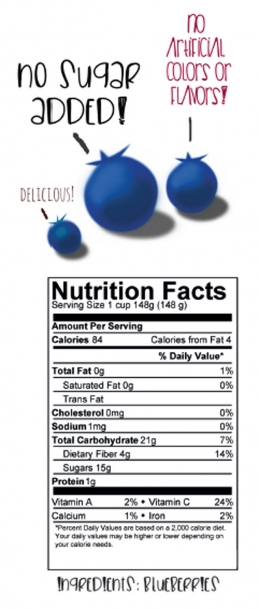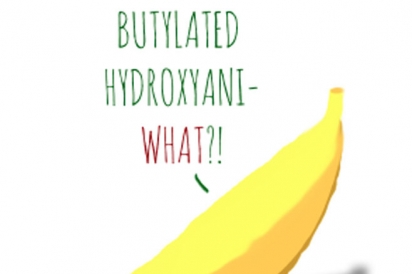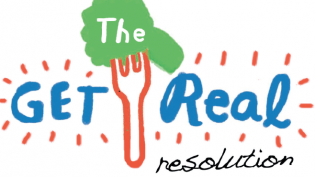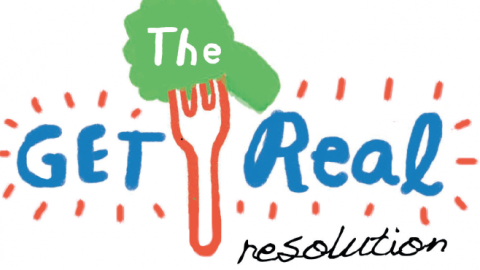Get Real Resolution: March (Food) Label Madness
You’ve heard of “March Madness,” here’s a different kind of madness that happens every day with your favorite foods. We call it “Label Madness!”
This month’s resolution helps you become a supermarket sleuth so you can spot the madness and understand what all those words on a food package really mean. Ready to investigate?
Let’s pick a food that seems pretty healthy and tastes good, too: blueberry yogurt. It’s got blueberries in it — one of the healthiest foods — it should be good for you! Or is it? What’s on the label?
Front of the package
The front of the package is the place where food companies want you to look first. The things written on this part of the label are what food companies want you to think about the food so you will buy it.
You’ll find words like “naturally flavored,” “lower sugar,” and lots of claims about what kind of vitamins and minerals the food has in it.
Mostly, these claims all sound like good things, but read them carefully. For example, terms like “natural” and “naturally” are not always what they sound like.
You would think that in order to make blueberry yogurt, you would just add blueberries, right? Because blueberries are expensive, food companies often use a little bit of real blueberries and add extra flavors to make a food taste a lot more like blueberry and colors to make it look more like blueberry.
The word “natural” is sometimes used when these flavors and colors are not created from chemicals but come from a natural source (which does not have to be a blueberry!). Some foods don’t even have real blueberries in them! Those labels will say things like “blueberry flavor.”
So, how do you find out the truth about what’s in your food?
Ingredients List
If you want to know what’s in your food, turn the package over and read the ingredient list. Here is where you can see what’s really in the package.
For our yogurt, the ingredients list can look like this: Cultured Lowfat and Nonfat Milk, Sugar, Blueberries, Modified Corn Starch, Blueberry Flavor, Natural Flavors, Kosher Gelatin, Colored with Fruit and Vegetable Juice, Vitamin D3.
Ingredients are listed in order of how much is used in the food. This list tells us that our yogurt contains more sugar than it does blueberries!
For foods like sweetened cereals, companies sometimes use a few different kinds of sugars (maltose, dextrose, corn syrup, fructose to name a few) so that sugar doesn’t show up first in the ingredients list. Some cereals contain more sugar than they do the “whole grains” they are supposed to contain!
The label also tells us that the yogurt has both natural and artificial flavors, not just blueberries. To make the yogurt look more like blueberry, they’ve used food colors.
Ingredients: Blueberries
What is THAT?!
Sometimes foods have ingredients you can’t pronounce like BUTYLATED HYDROXYANISOLE or CARRAGEENAN. What is all that?
If these ingredients don’t sound like food, you are right. These are food additives, things that are often added to food to keep it fresh or to help processed food keep its texture when it sits on the shelf a long time. Artificial colors and sweeteners are other examples of food additives.
The Nutrition Label
The nutrition label is also on the back of the food package. This label helps you understand things like how many calories are in it and how much of some nutrients it contains.
Nutrients are the healthy things foods offer us, like protein or vitamins and minerals. Some foods have added “nutrients” to help it sound healthier.
The nutrition info box also shows a percentage of each nutrient. This tells you how much of a nutrient a food item has compared to how much of that nutrient you should eat every day.
The nutrition label also shows some of the things you should avoid eating too much of, like added sugars, salt and saturated fats. Some yogurts have 26 grams of added sugar in them, that’s over five teaspoons of sugar!
This is an important label, but be careful when you read it. It can be tricky. A food item that looks like you can eat the whole thing as a snack may list its nutrition label as two or three servings. If you eat the whole thing, you have to triple the calories, sugars and fats that you think you are eating! Sneaky, huh?
Activity: Become a Supermarket Sleuth
You will need:
• A parent to take you to the grocery store and help you on the computer or at the library
• A notebook and pencil
• Blank paper at home with markers or crayons
Step 1: Look for Clues
Before you choose one food to investigate, take some time to read the label on the front of the packages you see in the store’s aisles. Write down some of the claims you notice on the front of the boxes. Save this list to investigate later with your mom or dad. Then, choose one food that sounds healthy on the front of the package.
Step 2: Investigate the Ingredients
Turn the item over and read the ingredients. Write down answers to following questions:
- How many ingredients are there?
- Do the ingredients match what you thought would be in the food?
- Are there any ingredients that don’t sound like food?
- Does the food use flavorings or colorings?
Step 3: Know the Nutrition Facts
Read the nutrition label to understand if the food is really good for you. Write down your answers.
- How many servings are in the package? Does that match what you thought?
- How much sugar, salt and saturated fat are in the food for each serving? Your mom or dad may have to help with the math.
- Does the food offer good nutrients? How much of each?
Step 4: Make Your Own Food Label
Choose a fruit or vegetable from the produce section to take home. You will use this to make your own label.
- Use the links offered here to help you make the nutrition label and learn about your food.
- The ingredient list is easy! It should be just one ingredient.
- Now, what health claims can you put on the front of your “package?”
- How does this food label compare to the one you read at the store?
Kid-safe Sites to Research Food Labels
Food Labeling Chaos – A Full Guide
For Parents
Do you ever dread taking your child to the grocery store? That nag factor that causes so many arguments over food choices can make you crazy. This month’s activity will help you and your child to have conversations about food choices instead of arguments.
Food labels are confusing, even for adults, so this is a great activity to do together. The online resources listed here will give you a great start to tame the food label madness. This skill set is key to helping your child become an informed consumer. It’s also a good time to talk about marketing claims and what they really mean. Good luck!
We’d love to see your kids’ food label projects! Please share them with us on The Cleaner Plate Club or Edible Kansas City’s Facebook pages.








